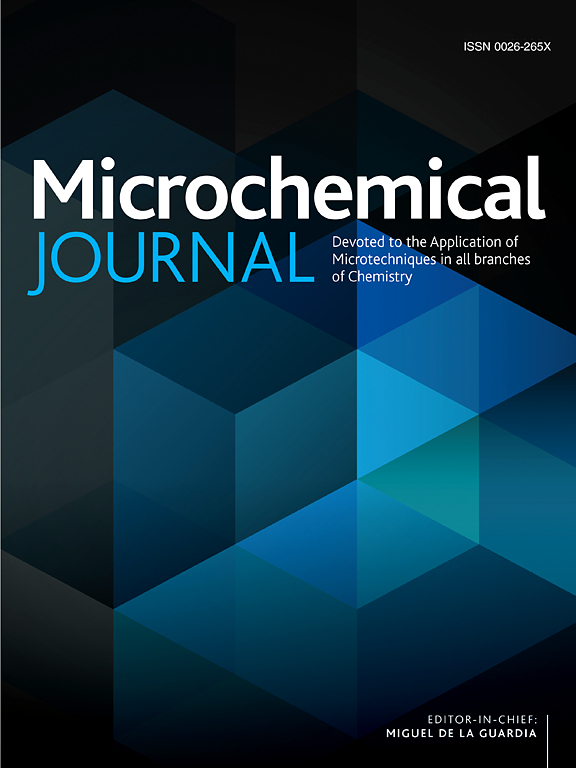基于多源分子光谱数据融合和机器学习的鲑鱼品质评估准确性研究
IF 4.9
2区 化学
Q1 CHEMISTRY, ANALYTICAL
引用次数: 0
摘要
分子光谱学已成为现代食品质量监测的重要工具。然而,依靠单一的光谱技术进行无损食品质量检测在准确性和全面性方面存在局限性。本文提出了一种融合近红外(NIR)和拉曼光谱(Raman)数据的新方法,用于同时评估不同储存条件下鲑鱼(Salmo salar)的品质性状。本研究以Warner-Bratzler剪切力(WBSF)和α-螺旋含量等关键指标为重点,通过机器学习,包括偏最小二乘(PLS)和最小二乘支持向量机(LSSVM),结合二维相关光谱和主成分分析(PCA),加强预测建模。研究显示显著的正相关(p <;α-螺旋含量与主要品质性状(保水性(r = 0.66)、水密度(r = 0.67))之间的关系为0.05)。将WBSF和α-螺旋作为评价三文鱼贮藏质量的潜在生物标志物。在预测建模方面,低水平数据融合LSSVM (LLDF-LSSVM)模型在估计WBSF值方面表现优异(R2P = 0.916, RMSEP = 0.201),优于中等水平数据融合(MLDF)和单光谱模型。此外,MLDF-PCA-LSSVM模型在预测α-螺旋含量方面表现出色(R2P = 0.984, RMSEP = 0.415),提高了PCA特征提取技术预测蛋白质二级结构的准确性。通过将光谱学和先进的机器学习相结合,研究结果为实时质量监测提供了新的见解,支持增强食品安全协议并减少海鲜供应链中的浪费。本文章由计算机程序翻译,如有差异,请以英文原文为准。
Improving the accuracy of quality assessment for salmon (Salmo salar) by multi-source molecular spectroscopy data fusion and machine learning
Molecular spectroscopy has emerged as a vital tool for modern food quality monitoring. However, relying on a single spectroscopy technique for non-destructive food quality testing presents limitations in accuracy and comprehensiveness. Here, a novel approach integrating near-infrared (NIR) and Raman spectroscopy data fusion to simultaneously assess salmon (Salmo salar) quality traits under varying storage conditions was developed. By focusing on critical indicators such as Warner-Bratzler shear force (WBSF) and α-helix content, the research aimed to enhance predictive modeling through machine learning, including partial least squares (PLS) and least squares support vector machine (LSSVM), combined with two-dimensional correlation spectroscopy and principal component analysis (PCA). The study revealed significant positive correlations (p < 0.05) between α-helix content and key quality traits, including water-holding capacity (r = 0.66) and WBSF (r = 0.67). WBSF and α-helix were used as potential biomarkers for evaluating the quality of salmon during storage. For predictive modeling, the low-level data fusion LSSVM (LLDF-LSSVM) model demonstrated superior performance in estimating WBSF values (R2P = 0.916, RMSEP = 0.201), outperforming mid-level data fusion (MLDF) and single-spectroscopy models. Additionally, the MLDF-PCA-LSSVM model showed excellent performance in predicting α-helix content (R2P = 0.984, RMSEP = 0.415), enhancing the accuracy of the PCA feature extraction technique for predicting protein secondary structure. By bridging spectroscopy and advanced machine learning, the findings offer novel insights into real-time quality monitoring, supporting enhanced food safety protocols and reducing waste in the seafood supply chain.
求助全文
通过发布文献求助,成功后即可免费获取论文全文。
去求助
来源期刊

Microchemical Journal
化学-分析化学
CiteScore
8.70
自引率
8.30%
发文量
1131
审稿时长
1.9 months
期刊介绍:
The Microchemical Journal is a peer reviewed journal devoted to all aspects and phases of analytical chemistry and chemical analysis. The Microchemical Journal publishes articles which are at the forefront of modern analytical chemistry and cover innovations in the techniques to the finest possible limits. This includes fundamental aspects, instrumentation, new developments, innovative and novel methods and applications including environmental and clinical field.
Traditional classical analytical methods such as spectrophotometry and titrimetry as well as established instrumentation methods such as flame and graphite furnace atomic absorption spectrometry, gas chromatography, and modified glassy or carbon electrode electrochemical methods will be considered, provided they show significant improvements and novelty compared to the established methods.
 求助内容:
求助内容: 应助结果提醒方式:
应助结果提醒方式:


